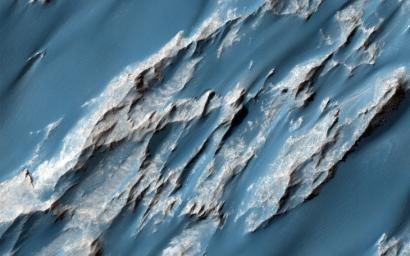
|
Hydrated Sulfate Landslides in Ophir Chasma
- Click the image above for a larger view
- Full-Res JPEG (2880 x 1800) (801.0 kB)
- Full-Res TIFF (2880 x 1800) (15.6 MB)
Caption:
Giant landslides in Ophir Chasma host a variety of geologic surfaces and mineralogies. Some possess a variety of hydrated sulfate minerals that formed in the presence of partially acidic liquid water.
This image of an ancient, approximately 3 billion year-old landslide shows two distinct surface albedos, which are proportions of reflected light. These different toned surfaces also mark a transition from one sulfate mineralogy to another and variations in surface evolution.
The upper slopes to the north are light-toned due to an abundance of hydrated sulfate minerals and bright surface dust . The surfaces that make up the southern portions of the landslide are darker in tone due to the greater frequency of dark sediment that form strings of sand drifts. Additionally, the underlying units of bedrock consist of darker minerals with less hydration then those to the north, implying a change in the ancient aqueous environments that formed them.
Background Info:
HiRISE is one of six instruments on NASA's Mars Reconnaissance Orbiter. The University of Arizona, Tucson, operates the orbiter's HiRISE camera, which was built by Ball Aerospace & Technologies Corp., Boulder, Colo. NASA's Jet Propulsion Laboratory, a division of the California Institute of Technology in Pasadena, manages the Mars Reconnaissance Orbiter Project for the NASA Science Mission Directorate, Washington.
Cataloging Keywords:
| Name | Value | Additional Values |
|---|---|---|
| Target | Mars | |
| System | ||
| Target Type | Planet | |
| Mission | Mars Reconnaissance Orbiter (MRO) | |
| Instrument Host | Mars Reconnaissance Orbiter | |
| Host Type | Orbiter | |
| Instrument | High Resolution Imaging Science Experiment (HiRISE) | |
| Detector | ||
| Extra Keywords | Color, Dust, Water | |
| Acquisition Date | ||
| Release Date | 2013-11-20 | |
| Date in Caption | ||
| Image Credit | NASA/JPL-Caltech/Univ. of Arizona | |
| Source | photojournal.jpl.nasa.gov/catalog/PIA17702 | |
| Identifier | PIA17702 | |
